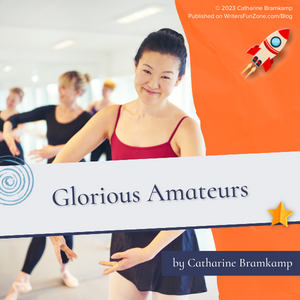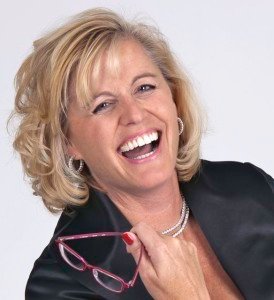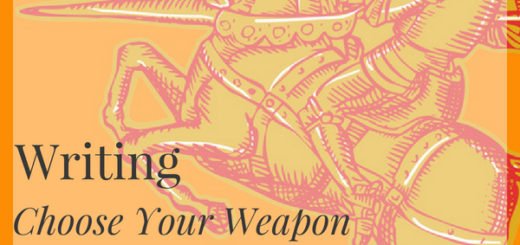Glorious Amateurs by Catharine Bramkamp
 Let’s welcome back monthly columnist Catharine Bramkamp as she shares with us “Glorious Amateurs.” Enjoy!
Let’s welcome back monthly columnist Catharine Bramkamp as she shares with us “Glorious Amateurs.” Enjoy!
***
My dance instructor is distressed. A local (professional) dancer has loudly announced that amateur dancers have no business on stage.
Only professionals deserve to perform in public. The rest of us should stay glued to our balcony seats keeping to our role as audience.
I find this attitude not only elitist, but very wrong. Wrong about the purpose of art and mistaken about the origins of art along with a complete misunderstanding about exploratory breakthroughs.
Since the Enlightenment, art and science has consistently and continuously been professionalized.
After almost 300 years of exclusionary efforts it’s difficult to unpack how very effective professions have denigrated those individuals who do not fit into the deep cavities of professional criteria and marginalize them as mere amateurs. Amateurs beneath notice.
Except the professionals are wrong.
Who else but a mere amateur has the courage, faith and out-of- the-dissertation -requirement thinking to confound and pester the establishment?
Who else can say no to a PhD but yes to a lifetime of scholarship?
We owe a great deal to our persistent amateurs.
Mary Anning
As a girl, five year old Mary Anning (1799–1847) loved to collect fossils and specimens along the chalk cliffs of her Lyme Regis home.
At age 12 Mary painstakingly uncovered the 5.2 meter skeleton of the first discovered. Her ichthyosaur from the Jurassic period.
She was a major contributor to the nascent study of prehistoric life. But like so many amateurs, while she freely shared her work, the male scientists who benefited, did not share the favor, nor give her credit.
She died of breast cancer at 47.
We could say, oh, what a waste, but that would be wrong.
Mary spent her life doing exactly what she wanted, which was a tremendous feat of female agency in the early 19th century.
Don’t cry, she is more famous today than all those men who had ignored her during her lifetime.
Gregor Johann Mendel
Gregor Johann Mendel was a 19th century monk who loved nothing more than full days working with pea plants.
After nine years of experimentation, he gave a two-part lecture demonstrating that traits of pea plants were either dominant or recessive.
Mendel sent his published lecture to all the scientists in the field, including Charles Darwin.
But his paper and findings were ignored because really, who was he?
Perhaps discouraged at the cold reception, Mendel continued his career as the elected abbot of his monastery and happily lived out his days tending his garden.
Finally, in 1900, scientists “discovered” Mendel’s work. We take recessive and dominant gene theory for granted, we have a mere amateur to thank for that crucial scientific discovery.
Susan Hendrickson
Back to fossils and exceptional women.
Another enthusiastic amateur, Susan Hendrickson worked with Peter Larson, the founder of the Black Hills Institute, a private organization specializing in fossil hunting.
On August 12, 1990, Hendrickson set off to investigate a cliff that had caught her attention. She spent two weeks on that cliff searching for fossils, and finally found it: the largest and most complete skeleton of a Tyrannosaurus Rex ever discovered.
Unlike Mary Anning, Hendrickson was recognized for her work during her lifetime. The enormous skeleton was named “Sue” in her honor.
While Susan failed to finish high school, in honor of her amateur work, she was awarded an honorary PhD. from the University of Illinois at Chicago.
So there.
Sylvia Beech
Sylvia Beech left her family in New Jersey to pursue her love of books as well as her love for long time partner, Adrienne Monnier.
With no experience, Beech opened and ran her now famous bookstore, Shakespeare & Company (at the time in the 20’s it also functioned as a lending library, with some customers, like Ernest Hemingway never returning the books he borrowed).
When customer James Joyce couldn’t find a publisher for his controversial novel, Ulysses, Beech stepped in.
She had no publishing experience, but did want to help.
She was happy to be part of the process and over the years, delighted in Joyce’s success. The book not only earned notoriety, it was also one of the pivotal works that established modernism.
Thanks to an amateur who just took a chance, and took the leap of faith.
The Power of the Amateur
Amateurs are often the artists who speak truth to power.
Sometimes because we don’t know better, or don’t fully understand the subtleties of professional (academic) behavior. And sometimes we do it on purpose, purposefully forgoing the club motto and secret handshake.
Un-invested in the survival of any system, the amateur is free to be bold and daring as well as discover and assemble information that is radically different than prevailing common wisdom.
Like the Wright brothers, who year after year showed up on the beach dunes at Kittyhawk, amateurs are in it for the love. We love the work, we love the people we work with, we love contributing to a purpose larger than ourselves.
Back to the Dance
As an expression of her absolute disagreement that amateurs can’t perform on stage, my instructor created a dance that pitted the sea witches (them) against the mermaids (us) to illustrate there was room on the stage for everyone. We presented the dance at the local theater that welcomes both professional and amateur acts.
We took our stand, armed with swords, fan veils, and elaborate shell crowns.
I won’t claim it was all perfect, but neither are “professional” efforts.
We, like the Wright brothers, like Sylvia Beach, were thrilled with the opportunity to practice our art.
For a culture to thrive, we must include all expressions of art: hanging in the Met or hanging in the local fairgrounds Hall of Flowers.
Don’t allow anyone to derail your passion just because you aren’t paid to practice it.
That is no way to treat a true lover.
***
Want to read more articles like this one Writer’s Fun Zone? Subscribe here.
***
ABOUT THE AUTHOR
 Catharine Bramkamp is a successful writing coach, Chief Storytelling Officer, former co-producer of Newbie Writers Podcast, and author of a dozen books including the Real Estate Diva Mysteries series, and The Future Girls series. She holds two degrees in English and is an adjunct university professor. After fracturing her wrist, she has figured out there is very little she is able to do with one hand tied behind her back. She delights in inspiring her readers.
Catharine Bramkamp is a successful writing coach, Chief Storytelling Officer, former co-producer of Newbie Writers Podcast, and author of a dozen books including the Real Estate Diva Mysteries series, and The Future Girls series. She holds two degrees in English and is an adjunct university professor. After fracturing her wrist, she has figured out there is very little she is able to do with one hand tied behind her back. She delights in inspiring her readers.






